Balancing Li-Po Battery Packs
- how & why it should be done
When talking about balancing Li-Po battery packs, we're not talking about finding their correct Centre of Gravity! Instead, the balance refers to the voltage of each cell in a pack relative to the other cells.
Li-Po (aka lipo, Li-Poly & lithium polymer) battery packs are now commonplace in the radio control flying hobby and have helped change the face of the hobby, since their introduction in the early 2000s.
A good quality Li-Po pack in conjunction with a powerful outrunner brushless motor can give an electric rc airplane or helicopter incredible performance and flight times; indeed a good electric setup is perfectly comparable to an IC powered aircraft these days.
Li-Po battery packs can be single cell or multi cell; a single cell has a nominal voltage of 3.7V and so packs can be bought in increments of 3.7 i.e. a single cell 3.7 volt pack, a two cell 7.4 volt pack, a three cell 11.1 volt pack - and so on.
Incidentally the number of cells in a pack is denoted by the letter S, so 1S, 2S and 3S written on the pack means one cell, two cell and three cell respectively.
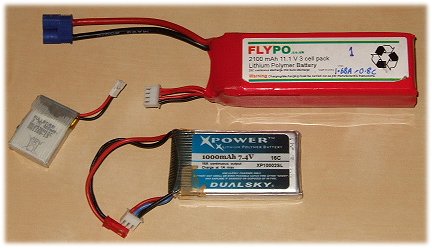
Above: single cell (1S), two cell (2S) & three cell (3S) Li-Po packs.
Obviously a single Li-Po cell can't be balanced against itself, but any pack with two or more cells should be balanced - if not with every charge then certainly on a regular basis.
Balancing Li-Po battery packs ensures that each cell matches the voltage of the other one, or as closely as possible, to prevent irregular current flow and hence give your rc airplane or helicopter, and the pack itself, optimum performance.
Balancing also preserves the longevity of the pack by protecting it against possible damage.
It's generally accepted that a difference of 30 - 50mV (.03 - .05v) between cells is acceptable, but different manufacturers might state different amounts. So, the specifications for your particular pack, where available, should be read and followed.
How To Balance Li-Po Battery Packs
You'll be relieved to hear that there's no great secret to balancing Li-Po battery packs!
A multi-cell pack should have two sets of leads coming out of it; one set connects to the ESC and is made up of a red (positive) and black (negative) lead and the other set will be made up of thinner wires that all go into a single white connector, with each separate wire coming from each cell. This is the balancing connector and the number of wires going into it will be determined by how many cells the battery pack has.
A 2S pack will have 3 wires - one for each cell plus a negative; a 3S pack will have four wires - one for each cell and a negative, a 4S pack five wires etc.
To balance the pack you need a charger with a balancing feature![]() Product sold on Amazon. As an Amazon Associate I may receive a small commission if you buy, at no extra cost to you. Thanks for your support, it helps keep RC Airplane World alive!, or a separate Li-Po balancer used in conjunction with a charger.
Product sold on Amazon. As an Amazon Associate I may receive a small commission if you buy, at no extra cost to you. Thanks for your support, it helps keep RC Airplane World alive!, or a separate Li-Po balancer used in conjunction with a charger.
The charger needs to be specific for lithium polymer batteries, you cannot use an NiMH or NiCD charger on Li-Po packs because the charging algorithms are different between the chemicals. Trying to charge and balance a Li-Po battery pack with anything other than a Li-Po specific charger presents a potential and real fire hazard, so do not try it.
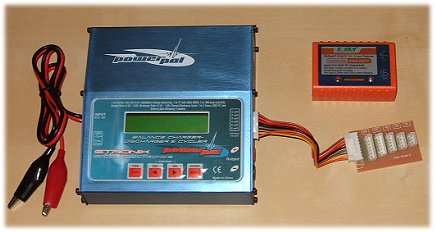
Above: a quality charger with separate balancing board, shown
alongside a cheap & simple Li-Po specific charger (top right).
There are many different battery chargers available, some very basic and some very complex. The most basic ones often sold with RTF aircraft may only feature a socket for the balancing connector and will charge through that, while others will charge the pack through the main ESC leads and balance the cells via the white connector at the same time.
When it comes to charging and balancing your li-po battery packs always follow your specific charger instruction manual carefully and don't take risks.
Is your Li-Po pack Balanced?
There are a couple of ways to check whether your Li-Po pack is balanced.
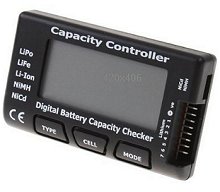 The easiest is to buy a battery checker, such as the one pictured right. You simply plug the white balance connector of the pack into it and click the appropriate button to cycle through each cell. Battery checkers like this are a great (and essential) gadget to have to hand, both in the workshop and at the field.
The easiest is to buy a battery checker, such as the one pictured right. You simply plug the white balance connector of the pack into it and click the appropriate button to cycle through each cell. Battery checkers like this are a great (and essential) gadget to have to hand, both in the workshop and at the field.
The second method requires the use of a voltmeter/multimeter and a bit of simple arithmetic...
With the negative lead of the voltmeter touching the negative terminal of the white balance connector of the pack, touch the positive lead of the meter on to each of the other terminals of the connector, one at a time. Determine the highest reading (i.e. the total voltage of the pack) and then move the meter lead to the next terminal, this will give you a lower reading. Calculate the difference between the two readings, this gives you the voltage of the first cell. Now touch the meter lead on the next terminal and subtract this voltage from the second terminal reading - this will give you the voltage of the second cell. Work your way through each terminal until you arrive at the last one, the reading of which will be the voltage of the last cell in the pack.
By calculating the voltage differences between each cell, you'll be able to see how well the pack is balanced.
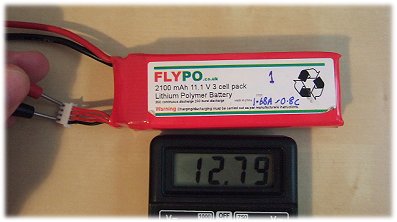
Above: step 1, get the battery pack total voltage - here it's 12.79V.
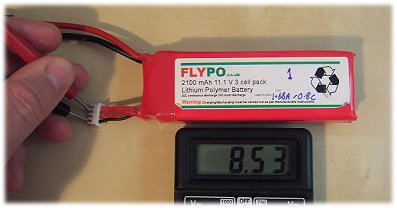
Above: step 2, get the next voltage level down and subtract
from the first - here it's 12.79 - 8.53 = 4.26V.
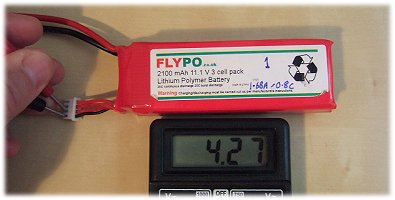
Above: step 3, repeat for each cell of the pack - 8.53 - 4.27 = 4.26V.
So, for the above example we have three cells nicely balanced at 4.26v, 4.26, and 4.27v. Huh? Personally I think I need a new voltmeter, because those values are actually higher than the proper voltage checker gave, and a Li-Po cell should never be over 4.2V! But you get the idea ;-)
Balancing Li-Po battery packs should be done regularly and you should get in to the habit of checking the balance often. A poorly balanced pack will give poor performance, and in the worst case scenario will be damaged beyond repair over time.
It's also important to understand that lithium polymer battery packs vary greatly in quality between brands, and it stands to reason that a better quality pack will probably balance better and stay balanced longer than a cheaper, lower quality one. Similarly, better chargers will balance better than cheaper ones.
